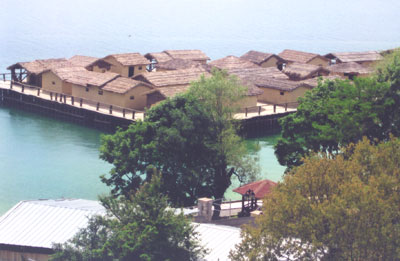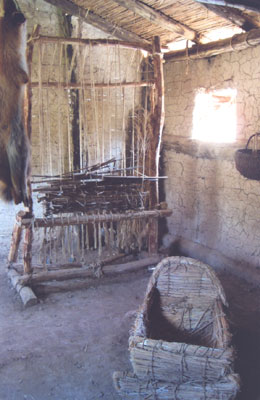Macedonia’s Bay of Bones
This item appears on page 62 of the December 2011 issue.
by Julie Skurdenis (part 3 of 3 on Balkans)
My husband, Paul, and I had visited Lake Ohrid on a trip to Albania in 2008. We loved what we saw then. Since Lake Ohrid is shared by both Albania and Macedonia, we decided we wanted to see the Macedonian side of the lake as well on our tour of Serbia, Kosovo, Macedonia and Montenegro arranged by Bestway Tours & Safaris.
Lake Ohrid is one of the oldest lakes on Earth, together with Baikal in Russia and Titicaca in Bolivia and Peru. It is also beautiful, with villas and little villages dotting its shores.
We had just visited the lovely, small monastic complex of Sveti Naum at the southeast corner of the lake and were driving north toward the town of Ohrid when our driver/guide asked us if we wanted to visit a palafitte. We had no idea whether he was talking about a church, a fortress or maybe even a café.
It turns out that a palafitte is a settlement built on piles or stilts usually over marshlands or water. What made if very interesting to us was that this particular palafitte was a reconstruction of one that actually existed there on Lake Ohrid 3,000 years ago.
Bay of Bones
Officially, it’s called Plocha Michov Grad Prehistoric Palafitte Settlement, but its more picturesque, popular name is Bay of Bones, for the bay where it’s located. The name “Bay of Bones” comes from the animal bones uncovered there, especially during underwater archaeological excavations conducted there since 1997.
What has also been discovered are thousands of artifacts dating from the late Bronze Age and early Iron Age, roughly around 1300-700 BC. In addition, more prosaically, thousands of wooden piles have been found in the lake bottom at a depth of about 10 to 16 feet. These piles once supported a large wooden platform with perhaps 20 to 24 dwellings constructed of wattle and daub, with thatch roofs. The platform was approached by a narrow wooden bridge linking it to the lakeshore.
The palafitte dwellers probably used the platforms seasonally, fishing from them during the warmer months while possibly tending their domestic livestock on land, although small enclosures outside individual houses on the platform may have held small animals.
In his fifth-century-BC “Histories,” Herodotus mentions Lake Ohrid, writing that babies were tied by the foot to keep them from tumbling into the water and that fish were so abundant “that a man has only to open his trap-door and to let down a basket by a rope” to get himself a good catch.
Palafitte interiors
The palafitte has been reconstructed to look the way it did 3,000 years ago. The houses are, more or less, the same size, but some have front “porches” shaded by thatch roofs extending from the main house. Others have small outside enclosures made of interwoven branches at a height of about three feet, reminiscent of modern patios but probably used for animals.
Most of the houses have either roll-down straw coverings for windows and doors or small, shutter-like contraptions made of branches that can be lowered over windows to protect against inclement weather. They are very modern looking.
Inside are small ovens for cooking and heating. There also are areas clearly marked off with waist-high interwoven branches and with straw strewn on the floor. These areas were used for sleeping. With breezes blowing in off the lake during the warm months, it was probably comfortable to live there.
Some of the houses display furnishings like large looms and baby cradles made of straw. Other items unearthed during excavation are displayed in the on-site museum on the lakeshore. There’s also a small coffee bar — a nice touch, we thought.
After the Palafitte dwellers
Such palafittes as this reconstructed one probably were not unusual around Lake Ohrid 2,000 to 3,000 years ago. In addition to palafitte dwellers, it is speculated that Philip of Macedon also may have lived at one time on Lake Ohrid in the fourth century BC.
We do know that the Romans arrived in the late second century BC and that Lake Ohrid was on the 700-mile-long Via Egnatia that led from Rome to Durres and Elbasan in Albania, then to Ohrid and Heraclea Lyncestis in Macedonia and on to Thessaloniki in Greece, finally culminating in Byzantium.
The first Christian basilicas were built beside the lake as early as the fifth century AD. The great Slavic saints Kliment and Naum made their appearance in the ninth to tenth centuries. Kliment is credited with the creation of the Cyrillic alphabet.
Highlights of Macedonia
Other highlights of our five days in Macedonia included the Roman archaeological sites of Stobi and Heraclea Lyncestis; the Mother Teresa Memorial House in Skopje, Macedonia’s capital (Mother Teresa was born in Skopje in 1910 into a Roman Catholic family of Albanian origin); the many churches both in the town of Ohrid and around the lake, especially the mosaics that are being excavated in a basilica believed to predate St. Kliment’s 10th-century church by as many as 500 years, and the atmospheric St. Kliment Hotel up a winding stepped street in Ohrid’s Old Town.
Of course, there’s the lake, itself, which is a UNESCO World Heritage Site. Dining beside the lake — with a glass of Macedonian white wine in hand — made Lake Ohrid perfect for us.
Finally, Montenegro
And, last but not least, was Montenegro, our final country on this June ’11 trip. Montenegro was the icing on our Balkans cake. We had three days to enjoy spectacular mountain scenery on the road from Kosovo into Montenegro and to savor the two walled Adriatic towns of Kotor and Budva, where we didn’t do much more than amble from one café to the next — a necessity for us after the previous 17 days of intense cultural sightseeing.
Kotor is beautiful, a medieval city within walls that at one point scale the heights of the mountain behind. There are plenty of tiny churches to explore, but here it was the restaurants and cafés tucked into corners that beckoned us. It was the perfect conclusion to our Balkans odyssey.
If you go…
Bestway Tours & Safaris (Burnaby, BC, Canada; 800/663-0844 or 604/264-7378) arranged our 20-day customized private tour of Serbia, Macedonia, Kosovo and Montenegro. I had traveled with Bestway twice before — to Iran and to Libya — so I expected this trip to be as good as those two had been. It was.
Our tour, which included hotels, car with driver/guide, tours, admissions and some meals, cost us $6,690 each. Airfare from New York to Belgrade cost extra.
For those who might prefer a group tour, Bestway offers a 20-day “Balkan Mosaic” trip twice each year that visits eight Balkan countries. Prices range from $6,070 to $7,875, depending on the number of participants (between two and 14).


